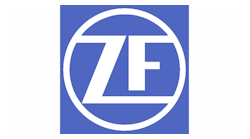At a recent global press event, ZF presented its latest solutions for current megatrends, including safety, automation, networking and electrification.
It has been a year since ZF acquired TRW, and CEO Stefan Sommer provided an update on the integration. The acquisition of TRW accelerated ZF’s growth to meet the demands of the megatrends and objectives they had as a company.
ZF’s latest advances were showcased at its test track and they focused around autonomy — connected mobility; safety — active safety, passive and avoidance; and efficiency — reducing fuel consumption and furthering electrification.
Bus Efficiency and Electrification
An articulated all-electric bus was featured, with the AVE 130 electric portal axle. With a voltage level of 400 volts AC instead of 350 volts AC as in the past, the AVE 130 electric portal axle is much more powerful. It can operate a fully loaded articulated bus, about 28 tons, with only one all-electric driven axle. The required installation space is the same as that of a conventional portal axle.
It has four motors and a maximum range of about 250 kilometers, though could go up to 300. The ideal charge is at night, four to five hours, but can be recharged in as little as one hour.
ZF has added a central drive to its electric drive portfolio, which can be combined with a direct or portal axle. It is best suited for high-floor applications and smaller buses. The new all-electric central drive moves the vehicle from a standstill to a final speed of up to 100 km/h comfortably and without interrupting the drive torque. The motor features a power output of up to 200 kW and provides a maximum torque of 4,200 Nm at output.
A coach bus with a prototype TraXon modular transmission for coaches demonstrated a system that allows increased efficiency. The basic transmission model, which comes with 12 or 16 gears, offers extremely high efficiency — primarily through its ability to handle up to 3,400 Nm of torque, its high transmission-ration spread of up to 99.7 percent and the outstanding power-to-weight ratio. ZF is evaluating the application on the test bus. TraXon provides fuel savings with heavy loads, while providing reliability and passenger and driver comfort, thanks to the variable, smooth and quiet gear transitions. At six decibles lower than its predecessor, the AS Tronic, TraXon returns a 35 percent improvement.
The transit bus with EcoLife automatic Transmission with a start/stop function offers a 5 to 10 percent reduction in fuel consumption. The new function automatically shuts off the engine when the bus comes to a standstill, reducing fuel consumption levels to zero. As the driver moves the foot from the brake to the accelerator, the engine and transmission are ready for an immediate start. This function is now available for the most frequent maximum engine torques in city buses, ranging from 1,000 to 1,600 Nm.
Sensing, Processing, Actuation
The theme of the global press event was, “See, Think, Act,” which are the basic three elements reflected in ZF’s technologies as intelligent mechanical systems provide effective control through smart systems. The strategic focus is on the truck market and with that, there is an enormous investment in core engineering cost. But, the technology is transportable and they intend to spread the technology across markets.
Cameras and sensors see the environment around the vehicle; high-level computers draw conclusions and calculate trajectories in safe environment; and the hardware moves the vehicle through traffic and decelerates.
ZF’s Innovation Truck featured Evasive Maneuver Assist in collaboration with Wabco, highway driving assist, and safe range assist. The Evasive Maneuver Assist combines Wabco’s braking, stability and vehicle dynamics control systems on trucks and trailers with ZF’s active steering technology. A radar sensor identifies moving or stationary vehicles ahead and alerts the driver via visual, audio and haptic signals of impending rear-end collisions. If the driver determines a collision cannot be avoided by driver-initiated or autonomous braking alone, evasive maneuver Assist engages to help the driver safely steer around the obstruction and bring the vehicle to a safe stop.
There were semi-trucks, a tractor and a passenger car equipped with the solutions toward ZF’s vision of accident-free traffic (Vision Zero). These vehicles have the various assist systems to boost safety and they are looking to transfer the technology to other markets to reflect on the megatrends.
While transit buses have a unique operating environment with starting and stopping in an often congested area and being full of passengers that aren’t restrained, it will be interesting to see how these technologies might be adapted to improve safety in this environment.



